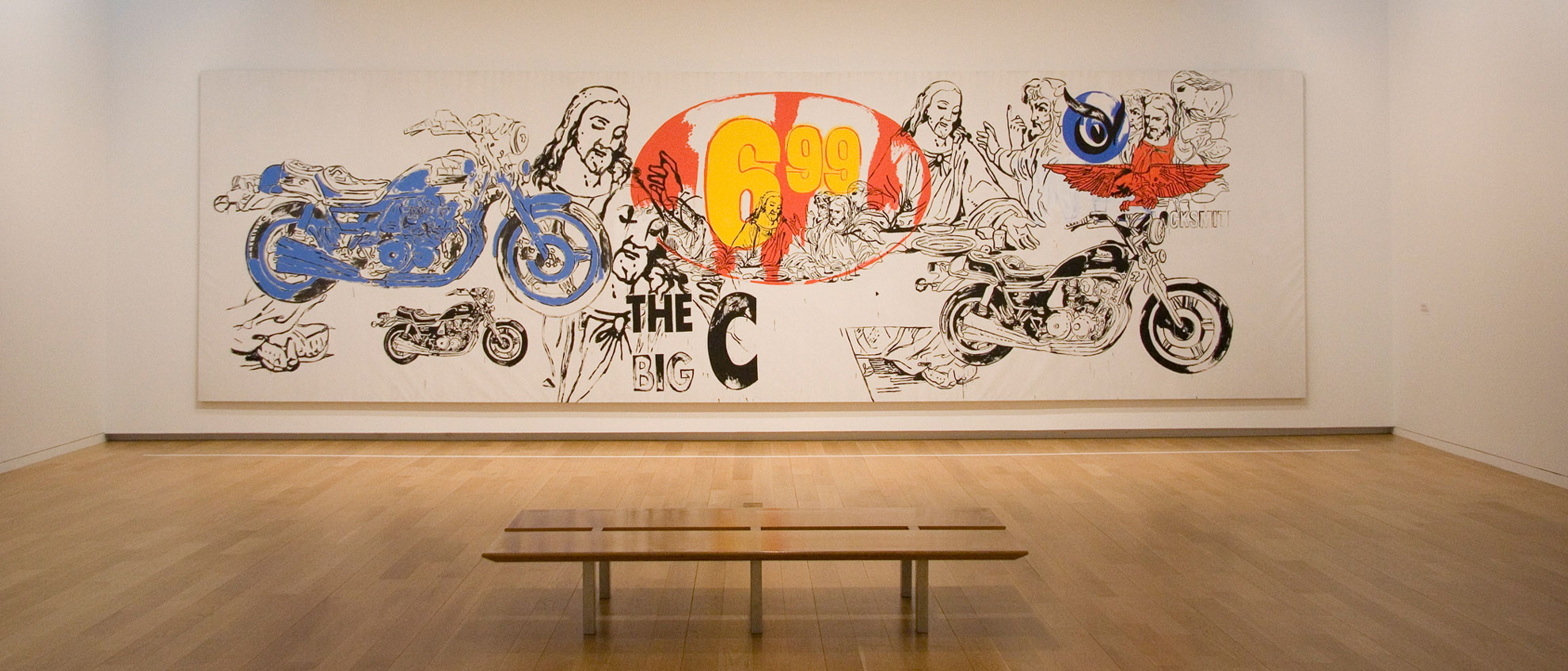Andy Warhol: The Last Decade

Andy Warhol
The Last Supper, 1986
Acrylic and silkscreen ink on linen
116 x 390 x 2 inches (294.6 x 990.6 x 5.1 cm)
Andy Warhol: The Last Decade features nearly 50 works by Warhol and examines how he simultaneously worked with the screened image and pursued a reinvention of painting in his late work. Created amidst the bustle of Warhol's Pop celebrity, the works included illustrate the artist’s vitality, energy, and renewed spirit of experimentation. During those final years, Warhol produced more works, in a greater number of series, than at any other time.
Critical to Warhol's reinvention of painting was the revival of the medium by the Neo-Expressionist painters. Warhol was both enamored with the new painting and challenged by it. He relished the youthful vitality of artists such as Jean-Michel Basquiat, Francesco Clemente, Keith Haring, and Julian Schnabel. Seeing the energy in their work and witnessing their popularity, Warhol began to work with new enthusiasm and eventually produced an extended series with Basquiat. His intimate working relationship with Basquiat during the years of 1983–84 certainly expanded his repertoire of painting techniques and dramatically increased his production—a stimulus that carried the artist through the end of his career.
Curator Andrea Karnes adds, "Surprise and revelation are two key components in this remarkable exhibition. Seeing Warhol's late work reveals the artist's renewed vigor for painting at the same time it brings to light aspects of his private and spiritual life."
In the 1970s, critics decried Warhol's society portraits as overtly commercial; and by the end of the decade, the artist remarked that, "The 1970s were sort of quiet. . . . In the '70s nothing really different happened in art." He then predicted, "I think the '80s are going to be a more exciting period." Around 1978 he began to produce a number of new series including Retrospectives and Reversals, in which he revisited his earlier subjects and attempted to rework them as a stimulus for new ideas. In another series, Shadows and Oxidations, he turned to abstract imagery for inspiration. This period of experimentation reached a critical head in 1979 when Warhol had two exhibitions presenting the two new poles of his work—Portraits at the Whitney Museum of American Art and Shadows at the Dia Art Foundation. Universally, critics dismissed the Portraits exhibition, but were elated by the new work in Shadows.
Throughout the 1980s, Warhol experimented with painting and silkscreen to develop a remarkable vocabulary of images that navigate the realms between drawing and painting by hand and screening images mechanically. In this new vocabulary of images he continued to re-create icons of mass culture. At the same time, though, he introduced subjects of great personal significance in his largest single series on death and religion. The result was a remarkably creative period in which Warhol produced commanding works of striking visual presence and compelling content reflective of the era and his personal beliefs. Over the next few years he oscillated between images created by hand and those created without the "touch of the artist," or a combination of both. Around 1982, Warhol created a series of painterly abstractions—his first ventures in this idiom—that reference Abstract Expressionism, but executed largely with silkscreens. In 1983 he did a series of Yarn paintings produced by the transfer of yarn patterns soaked in paint and pressed onto canvas. A year later he began his powerful abstract Rorschach paintings, created by hand, not by transfer.
Warhol's last great series—begun as a commission from an Italian art dealer and the largest of his career—was the Last Supper series (1985–86), based on Leonardo da Vinci's famous painting. Known only to close confidants, Warhol was a deeply religious man who routinely attended mass and observed Catholic doctrines. The artist worked on weekends to produce the Last Supper series, spending his work week screening portrait commissions. He described himself as a Sunday painter, working overtime to create the religious images to which he responded personally. He put the series on display in January 1987 in a gallery in Milan, across the street from da Vinci's famous masterpiece. Tragically, he died of gall bladder infection the following month, bringing a close to this dynamically creative period in his career.
Andy Warhol
The Last Supper, 1986
Acrylic and silkscreen ink on linen
116 x 390 x 2 inches (294.6 x 990.6 x 5.1 cm)
